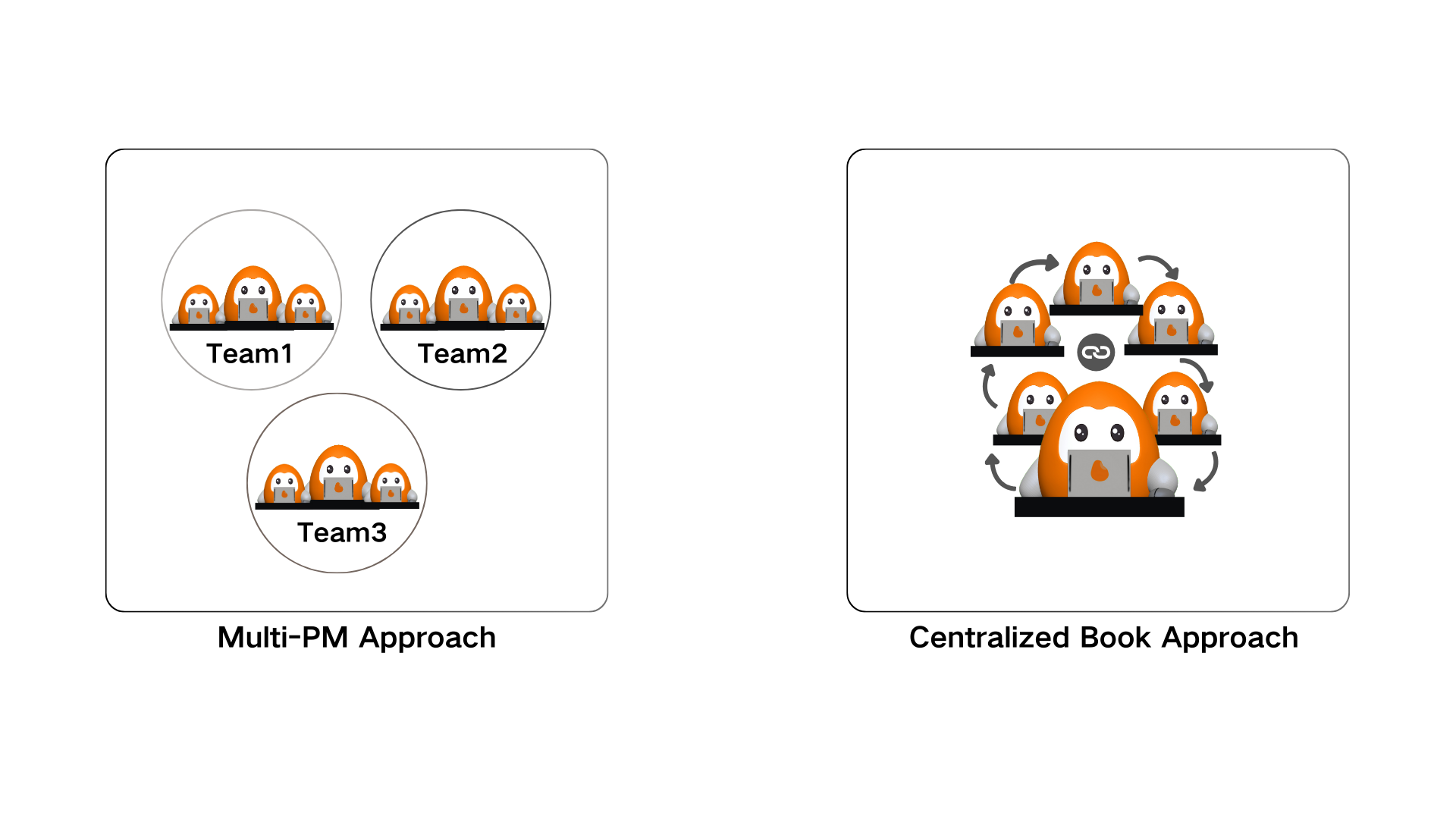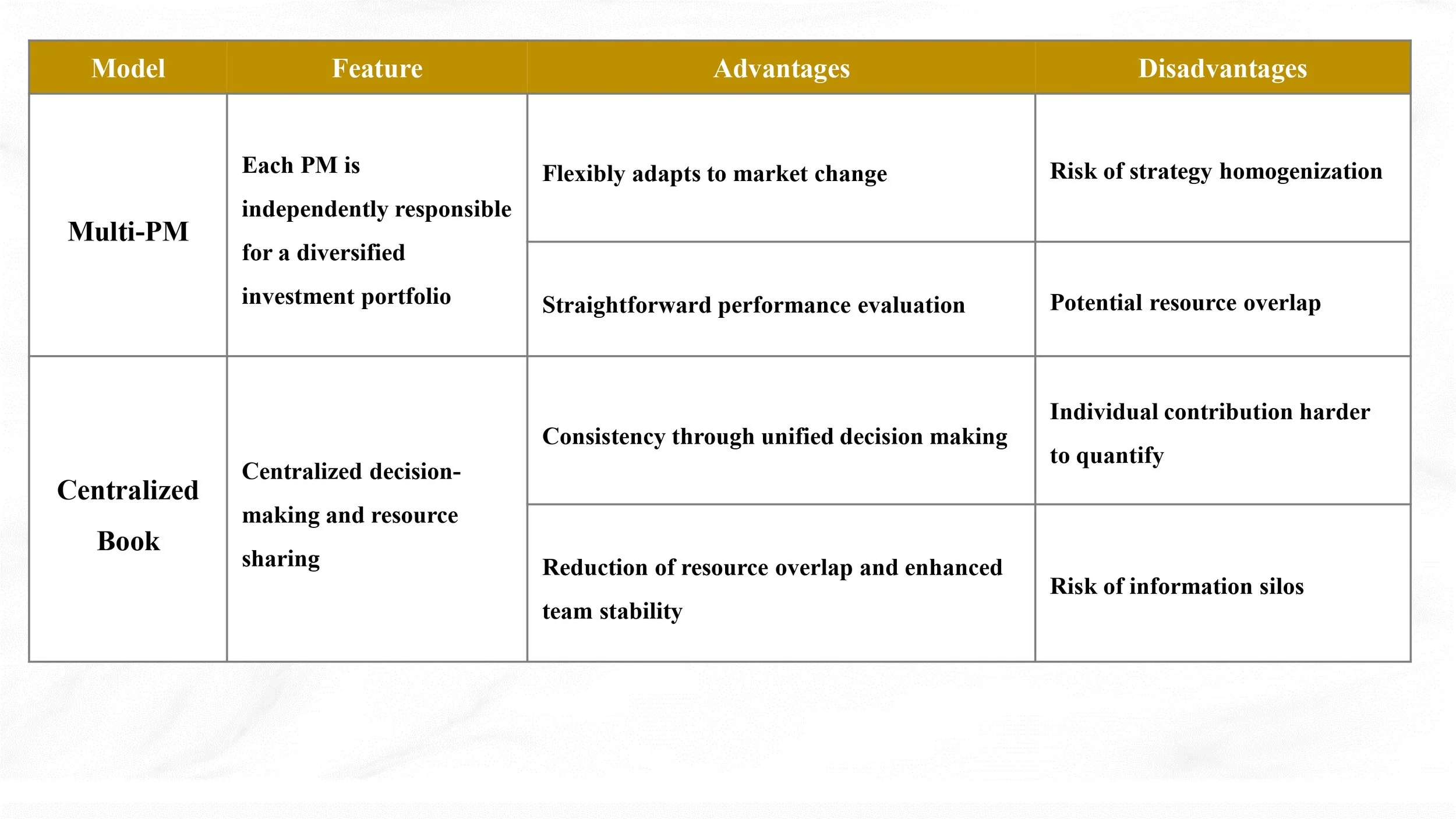Multi-PM vs. Centralized Book Approach: A Clash of Individual Heroism and Collective Wisdom
/In quantitative hedge funds, the Silo PM (or Independent Fund Manager model, also known as the Multi-Manager Platform) and the Centralized Book (Core Model) are two common organizational structures. These models shape distinct company cultures, influencing the decision-making processes, information-sharing methods, and member role assignments.
1. Multi-PM Model
In this model, each PM (portfolio manager) or team operates fairly independently, managing their own investment strategies, resembling individual 'islands.' While there is some sharing of resources and information, each PM retains a high level of autonomy, allowing for differentiation in strategies. Well-renowned hedge funds in the US, Europe, and Asia have employed this model, using independent competition to spur innovation.
2. Core Model
In contrast, the Core Model emphasizes close team collaboration. Researchers are responsible for different modules of strategies, piecing together a precise 'puzzle' under the guidance of a central leader who assigns tasks according to a unified strategic framework, aiming for an optimal global solution. This model, adopted by several large international hedge funds, seeks to maximize the power of collective intelligence.
In short, the Multi-PM model pursues competition-driven innovation—'individualism'—while the Core Model focuses on coordinated teamwork and rationality—'collectivism.'
SOURCE:JASPER.
Comparison of the Two Frameworks: Strengths and Challenges
The Multi-PM model can gather diverse strategies from different PMs, creating a varied portfolio that flexibly adapts to market changes and allows for simpler, straightforward performance evaluations. However, in an environment of strategy homogenization, a lack of information sharing can lead to resource wastage, and the performance of strategies may suffer if a PM departs.
The Core Model maintains consistency through unified decision-making, reducing redundant work and enhancing stability. However, because strategies are executed collaboratively by multiple members, individual contributions are harder to quantify, and information concentrated in one system may lead to 'information silos.' This model particularly depends on the Chief Investment Officer's management and decision-making skills, along with the team's continuous innovation.
These models inherently present a balance between cooperation and competition. The Multi-PM model resembles a 'non-cooperative game,' where strategy diversity makes the portfolio more flexible but risks redundancy. The Core Model, akin to a 'cooperative game,' pursues efficiency and consistency, challenging the team to overcome fixed thinking.
SOURCE:JASPER.
Making the Choice in China
In China’s quantitative hedge fund landscape, some firms successfully adopt the Multi-PM model to build MOM (Manager of Managers) investment platforms, while others have developed steadily through the Core Model. Since its inception, Jasper Capital has adhered to a Core Model framework, focusing on building an efficient, interconnected, resource-sharing research platform.
Renowned quantitative investor and author of *Advances in Financial Machine Learning*, Dr. Marcos López de Prado, mentioned in his talk, *Escaping the Sisyphus Trap: How Quantitative Researchers Can Fulfill Their Potential*, that the business value of the Multi-PM model is increasingly evident with the rise of AI and other technologies. However, he also warns that without effective teamwork, quantitative researchers in the Multi-PM model may fall into the 'Sisyphus Trap,' where they’re stuck in endless repetitive tasks, hindering innovation.
In contrast, the Core Model team, through interdisciplinary cooperation and unified process management, can efficiently solve problems while continuously refining strategies through coordinated efforts, improving overall efficiency and outcomes. A flat team structure supports a self-correcting mechanism, enhancing team execution.
At Jasper Capital, the traditional Core Model has been innovatively adapted into a refined, interactive collaborative system. The company's CEO and CIO leads strategy research, while researchers conduct independent project research, exchanging ideas and inspirations. The IT team provides technical support, and during major strategy iterations, the research and IT teams make decisions together to ensure every researcher participates in all stages of strategy development.
SOURCE:JASPER.
We have also established a 'people-centered' evaluation and incentive system, encouraging each member to utilize their strengths while sharing in the company’s growth, ensuring that every individual is fully utilized.
Jasper Capital believes that while the Core Model may face challenges in trust and efficiency at the beginning, its advantages become increasingly evident as the system matures. Especially as the A-share market's efficiency improves and price-volume factors become more homogeneous, the Core Model can bring together experts from various fields and allocate resources flexibly, deeply exploring fundamentals and alternative strategies to enhance model competitiveness.
As quantitative research in China matures, institutions are making new explorations and breakthroughs in team management. For example, Multi-PM model companies reduce redundant work by sharing underlying data and tools, while Core Model companies provide researchers with a broader perspective through project-based models.
With continuous trial and adjustment, more hedge funds are expected to find the optimal balance between individual efficiency, team collaboration, and strategy performance.




